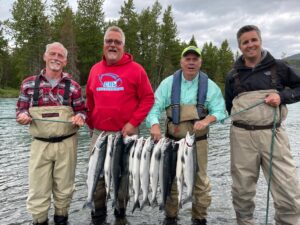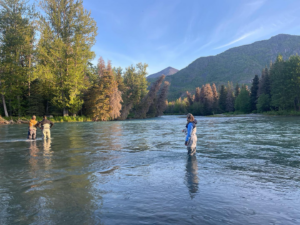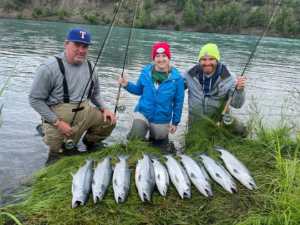As an Anchorage, AK fly fishing guide service, we know how much sound can influence success on the water. At Jason’s Guide Service, we’ve spent decades learning how even the smallest vibration can change a day’s outcome. While many people focus on gear or fly choice, few consider the powerful role of sound in the underwater world of Alaska’s fish.
Sound In Water
In the quiet stretches of the Upper and Middle Kenai River, sound travels differently. Water amplifies vibrations in a way that can either alert fish to danger or lure them in closer. Silence often becomes a strategic tool. When we’re working with seasoned anglers or first-timers, we remind them that sudden movements or clunky footsteps in a drift boat can send shockwaves through the water. Fish accustomed to calm environments are especially quick to spook.
At the same time, certain noises can work in our favor. The subtle slap of a fly hitting the water at the right angle, for example, might mimic the sound of prey. Some experienced anglers experiment with streamers that create light disturbance. Used skillfully, that bit of sound can imitate struggling baitfish and trigger aggressive strikes from territorial trout.
Understanding which sounds attract and which repel takes experience. That’s something we’ve built over 31 years guiding anglers in this region. We’ve noticed that some of the best fishing days happen when guides and guests stay in rhythm, keeping noise to a minimum until it’s time to make the cast count. Timing and control are essential, and that applies as much to sound as it does to technique. If you are new to the sport of fly fishing, our guides are here to help with everything from gear to the sounds you can make on the water.
The Kenai River offers a variety of conditions, from fast-moving stretches to calm, glassy pools. In quieter waters, fish are especially attuned to disturbances. That’s where body positioning, line handling, and even whispered communication become part of the strategy. Additionally, gear that helps keep things quiet is essential in these areas.
Vibration doesn’t just come from above the waterline, either. Wading anglers can generate subtle tremors with each step. We often coach clients to move slowly, not just for balance but to avoid setting off underwater signals. For our new anglers out there, a tip we often share is to avoid setting gear directly on exposed rocks as this action can create noises that travel far under water.
Our range is from the Upper Kenai down to Soldotna, which means we see different fish behavior depending on flow, depth, and time of year. In some seasons, a quiet approach is absolutely vital. In others, a more active presentation using small pulses of sound may be more effective.
Sound is an often-overlooked factor in fly fishing, especially in Alaska’s peaceful river systems. Whether it’s a subtle advantage or a potential misstep, how we manage noise can shape every experience. We help our guests learn these subtleties so they can fish smarter and connect more deeply with the environment. To learn more about how sound, movement, and local knowledge can elevate your time on the water, reach out to Jason’s Guide Service today.














